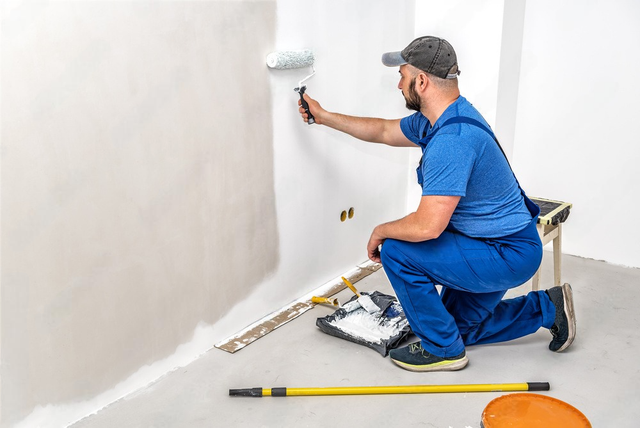Discovering the Different Kinds of Paint: A Guide for each Job
Discovering the different kinds of paint is important for attaining the desired result in any type of project. From water-based options that use benefit to oil-based paints known for their longevity, each choice has its advantages. Specialized paints can include unique structures or finishes, while environment-friendly alternatives accommodate those seeking sustainability. Understanding these distinctions can greatly impact the success of a painting venture. What aspects should one take into consideration when making the ideal selection?
Recognizing Paint Kinds: Water-Based vs. Oil-Based
Paint kinds can significantly impact a task's end result, and comprehending the differences between oil-based and water-based paints is crucial for educated decision-making. Water-based paints, frequently referred to as latex paints, are made up of water as the key solvent. They dry promptly, discharge fewer volatile organic substances (VOCs), and are simple to cleanse up with soap and water. This makes them a prominent selection for interior applications and settings where air high quality is a problem.
In contrast, oil-based paints make use of organic solvents, supplying a resilient, shiny coating suitable for surfaces revealed to damage, such as trim and closets. They take longer to dry, call for mineral spirits for cleanup, and have a stronger smell. paint store corpus christi tx. Selecting in between these 2 types depends upon the certain needs of the project, thinking about variables such as desired surface, application setting, and convenience of maintenance. Each type has unique benefits and limitations, leading the selection process
The Complete Issues: Picking In Between Matte, Satin, and Gloss
When picking a paint surface, the option in between matte and shiny alternatives significantly affects both aesthetics and functionality. Matte surfaces use a refined, non-reflective appearance that can hide surface flaws, while glossy surfaces give resilience and ease of cleaning. Comprehending the benefits and considerations of each can help in making an informed decision for any painting project.
Matte Finish Advantages
Lots of house owners dispute the values of different finishes, matte paint offers distinctive benefits that make it a prominent choice for both indoor and outside applications. One of the primary advantages of matte surface is its capability to hide surface area flaws, creating a smoother look on wall surfaces. This quality is specifically advantageous in older homes or areas with irregular surface areas. Additionally, matte paint soaks up light instead of mirroring it, which can improve the aesthetic of an area by offering an extra advanced and muted appearance. Matte finishes are commonly simpler to touch up than glossier alternatives, as they can blend extra seamlessly when used over existing paint. In general, matte paint is a superb option for those looking for a refined and classy finish.
Shiny Finish Factors To Consider
A glossy surface can significantly change the perception of an area, supplying a reflective and sleek high quality that boosts both color vibrancy and light within a space. This coating is usually favored for high-traffic locations and surface areas like bathroom and kitchens, where sturdiness and convenience of cleaning are vital. Its reflective nature can highlight imperfections on wall surfaces, making proper surface area preparation vital. Glossy paints also tend to show finger prints and smudges quicker, necessitating routine upkeep. In addition, lights plays a substantial duty; in bright environments, a shiny finish may create glare, impacting the overall aesthetic. Mindful factor to consider of the certain application and setting is vital when picking a shiny surface for any task.
Specialized Paints: When to Utilize Textured or Chalk Paint
Specialty paints, such as textured and chalk paint, offer unique visual and sensible advantages that can improve various surface areas. Distinctive paint is ideal for producing depth and dimension on wall surfaces, concealing imperfections while including a three-dimensional feel. It is particularly useful in high-traffic locations where sturdiness and visual passion are important.

Both sorts of specialty paints can transform spaces, but choosing the right one relies on the desired result and surface area needs. Distinctive paint may fit larger areas, while chalk paint can revitalize smaller sized products, showcasing imagination and personal style in any project.
Exterior Paints: Shielding Your Surface Areas From the Aspects
Outside paints are important for protecting surfaces versus different climate condition. Recognizing their climate resistance functions, appropriate surface prep work demands, and effective application techniques can greatly boost durability and efficiency. This area will certainly describe essential considerations for choose and utilizing outdoor paints properly.
Weather Condition Resistance Features
Climate resistance is a crucial function of exterior paints, as it identifies how well surface areas can withstand the rough aspects of nature. High-quality outside paints are formulated to withstand damage from UV rays, wetness, and temperature changes. UV resistance guarantees shades remain lively in time, protecting against fading and discoloration. Dampness resistance protects against mold and mildew and mildew, which can endanger the integrity of surfaces. In addition, paints with outstanding temperature level resistance can get and expand without fracturing, maintaining their safety top qualities. When choosing exterior paints, it is vital to think about these climate resistance features, as they add to the longevity and toughness of painted surfaces, making sure they remain visually pleasing and useful despite exposure to the components.
Surface Preparation Demands
Correct surface prep work is an essential action in attaining the very best outcomes with exterior paints. To assure optimal attachment and sturdiness, surface areas must be completely cleaned up, eliminating mold, dust, and grease. This can be accomplished utilizing a pressure washer or a scrub brush with a suitable cleaning solution. Once cleaned, surfaces need to be inspected for any peeling or flaking paint, which must be scraped away to develop a smooth foundation. Repairing any openings or splits is likewise essential, as these can allow dampness seepage. Additionally, sanding harsh locations advertises much better paint adhesion. Finally, using a guide fit for outdoor usage can boost the paint's efficiency, assuring a long-lasting finish that withstands the components. Proper prep work is crucial to an effective exterior paint project.
Application Strategies Tips
While using outdoor paints, it is important to make use of effective techniques that ensure surface areas are well-protected versus the aspects. First, pick the best day for paint; reduced humidity and moderate temperatures improve adhesion and drying out. Prepping the surface area thoroughly-- cleansing, sanding, and priming-- ensures much better paint attachment and longevity. Utilizing high-grade brushes or rollers can supply a smoother finish, while spray paint may cover big locations effectively. Using paint in thin, even layers avoids runs and drips. It is recommended to adhere to producer guidelines concerning drying out times between coats. Finally, confirm correct ventilation throughout application to facilitate drying out and minimize exposure to fumes. These strategies considerably boost the durability and performance of outside paint.
Eco-Friendly Options: Low-VOC and Zero-VOC Paints
As customers become significantly knowledgeable about the ecological influence of their choices, low-VOC and zero-VOC paints have actually become prominent options. These paints are developed to include less unstable natural substances (VOCs), which are chemicals that can vaporize into the air and add to air pollution and health issue. Low-VOC paints usually consist of a restricted quantity of VOCs, while zero-VOC paints have minimal degrees, making them much safer read more for both indoor and outside use.
The benefits of using low-VOC and zero-VOC paints expand beyond environmental considerations; they likewise improve indoor air high quality, minimizing the danger of respiratory system concerns and sensitive reactions. Many manufacturers now offer a variety of colors and finishes in environmentally friendly options, making it less complicated for consumers to locate appropriate items for their jobs. By selecting these paints, people can add to a much healthier atmosphere while still achieving the visual they prefer in their spaces.
Devices and Methods for a Perfect Application
Accomplishing a flawless paint application calls for the right tools and strategies, which can greatly improve the result. Choosing the ideal brush or roller is essential; brushes function well for edges and intricate locations, while rollers cover larger surface areas effectively. Making use of high-grade materials assures much better paint circulation and lessens streaks. For excellent results, surface area preparation is important. This consists of cleaning, fining sand, and priming surfaces to advertise bond.
Technique likewise plays a significant function. The "W" method with a roller assists to equally distribute paint, while long, smooth strokes with a brush protect against visible lines. Functioning in areas allows for far better control and blending. In addition, applying thin layers is more suitable to thick layers, lowering the danger of drips and irregular structures. Maintaining a wet edge throughout application helps accomplish smooth changes between areas. By incorporating these tools and methods, one can accomplish a sleek and professional coating.
Tips for Preserving and Caring for Your Painted Surfaces
Proper upkeep and treatment of coloured surface areas can significantly prolong their life expectancy and maintain their look. Regular cleaning is necessary; making use of a soft cloth or sponge with mild soap and water can remove dust and dirt without harming the paint. It is suggested to prevent rough cleansers or scrubbing pads, as these can scrape the surface. Additionally, applying a fresh layer of paint every couple of years can shield and renew the shade versus wear.
For outside surfaces, examining for signs of peeling or fading on a regular basis is necessary. Without delay resolving any type of problems avoids further damage. In locations susceptible to wetness, such as restrooms, using mold-resistant paint and guaranteeing proper air flow can aid preserve the integrity of the paint. Using protective coatings can protect against UV rays and discolorations, guaranteeing that repainted surface areas remain vibrant and enticing for years to come, inevitably enhancing the total aesthetic of the room.

Often Asked Concerns
Can I Mix Different Types of Paint Together?
Mixing different kinds of paint is usually not advised, as it can bring about concerns like inadequate attachment, irregular appearance, or unforeseen chain reaction. It's finest to utilize compatible paints for optimal results and sturdiness.

Just how Do I Appropriately Shop Surplus Paint?
To correctly save remaining paint, seal the container firmly, tag it with the day and color, and keep it in a trendy, completely dry area far from direct sunlight and extreme temperatures for ideal preservation.
What Is the most effective Means to Dispose of Extra Paint?
The very best way to get rid of extra paint is to inspect regional laws, as many areas have actually designated unsafe waste centers. Take into consideration donating useful paint to community companies or schools for their projects.
How Can I Tell if Paint Is Still Good to Make Use Of?
To establish if paint is still great, examine its consistency, color, and odor. If it shows up apart, has an undesirable odor, or shows substantial changes in texture, it's likely no more usable.
Are There Age Restrictions for Getting Paint Products?
In several regions, there are no specific age constraints for buying paint products. Nevertheless, some stores may call for customers to be at the very least 18 years of ages, specifically for items consisting of solvents or dangerous materials.
Paint types can substantially influence a task's outcome, and understanding the differences in between water-based and oil-based paints is essential for notified decision-making. Water-based paints, typically referred to as latex paints, are composed of water as the main solvent. In comparison, oil-based paints use organic solvents, offering a long lasting, glossy coating suitable for surfaces subjected to wear and tear, such as trim and cupboards. Specialty paints, such as distinctive and chalk paint, offer one-of-a-kind visual and sensible benefits that can improve various surface areas. In locations susceptible to dampness, such as restrooms, making use of mold-resistant paint and guaranteeing correct air flow can assist maintain the integrity of the paint.